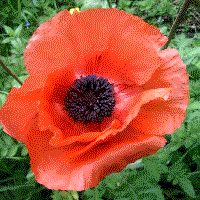 |
PAPAVERACEAE - The Poppy Family
This is quite a small family, with about 250 species found mainly in the northern temperate regions of the world. Many are familiar garden plants - Poppies, Meconopsis, Californian Poppies, Argemone and Dendromecon. Few are of economic importance, although the Opium Poppy (Papaver somniferum) is the source of opium and heroin, and its seeds are used in baking. Other species yield oils used in making soap. Most members of this Family are herbaceous annuals or perennials, but there are also a few shrubs. |
Characteristics of this Plant Family:
Leaves, Stem & Roots ~ The leaves of plants in this family are entire, but often deeply cut, and arise alternately up the stem. The stem may be smooth, hairy, or prickly. The sap is a milky latex, and it is this which gave the family its name - pappa is the Latin for food or milk. Instead of the normal calyx, members of this Family have two large sepals which enclose the flower bud, and these fall off when the bud opens.
Flowers ~ There are two rings of two large, rounded petals, except in Macleaya (Plume Poppy) and some tropical species. The petals are often crumpled inside the bud. There are many rows of stamens.
Seeds ~ The seeds develop inside a rounded capsule with one chamber, which opens by small holes around the lid.
Members of this Family usually have:
Two sepals enclosing the flower bud, which fall off when it opens.
Four brightly-coloured petals
Many stamens
Rounded seed pod forming inside the flower